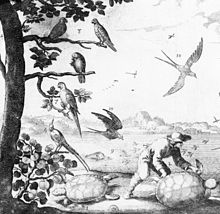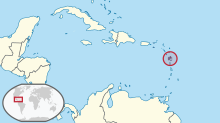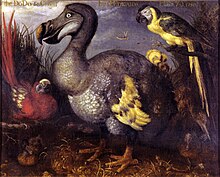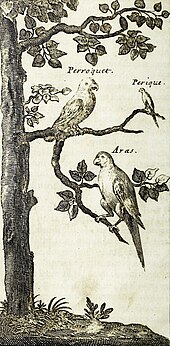Lesser Antillean macaw
| Lesser Antillean macaw | |
|---|---|

| |
Guadeloupe amazons (8) and one Lesser Antillean macaw (7) on a tree at the left
| |
Extinct (c. 1760)
| |
| Scientific classification | |
| Domain: | Eukaryota |
| Kingdom: | Animalia |
| Phylum: | Chordata |
| Class: | Aves |
| Order: | Psittaciformes |
| Family: | Psittacidae |
| Genus: | Ara |
| Species: | †A. guadeloupensis
|
| Binomial name | |
| †Ara guadeloupensis (Clark, 1905)
| |

| |
| Location of the Guadeloupe region | |
The Lesser Antillean macaw or Guadeloupe macaw (Ara guadeloupensis) is a
According to contemporary descriptions, the body of the Lesser Antillean macaw was red and the wings were red, blue and yellow. The tail feathers were between 38 and 51 cm (15 and 20 in) long. Apart from the smaller size and the all-red coloration of the tail feathers, it resembled the scarlet macaw and may, therefore, have been a close relative of that species. The bird ate fruit – including the poisonous
Taxonomy
The Lesser Antillean macaw is well-documented compared to most other extinct
The American zoologist
A small parrot
In 2015, a terminal

Later in 2015, Lenoble reviewed overlooked historical Spanish and French sources, finding references to mainly red macaws consistent with the Lesser Antillean macaw. The writings of the French missionary
As many as 13 now-extinct species of macaw have variously been suggested to have lived on the Caribbean islands, but many of these were based on old descriptions or drawings and only represent hypothetical species.
Description
The Lesser Antillean macaw was described as having similar coloration to the scarlet macaw, but with shorter tail feathers between 38 and 51 cm (15 and 20 in) long.[18] In contrast, the tail feathers of the scarlet macaw are 61 cm (2 ft) long and have blue tips, and the outer feathers are almost entirely blue. In spite of the tail feathers being shorter, it is not certain whether the Lesser Antillean macaw was smaller than the scarlet macaw overall, as the relative proportions of body parts vary between macaw species.[3] The tail feathers were longer than those of the Cuban macaw, which were 30 cm (12 in) long.[8] The morphology of the fossil phalanx bone from Marie-Galante was most similar to the second or third ungual of the scarlet macaw, though the bone is slightly smaller at 15.3 mm (0.60 in) compared to 15–17 mm (0.59–0.67 in).[13]
Du Tertre described the Lesser Antillean macaw as follows in 1654:
The Macaw is the largest of all the parrot tribe; for although the parrots of Guadeloupe are larger than all other parrots, both of the islands and of the main land, the Macaws are a third larger than they... The head, neck, underparts, and back are flame color. The wings are a mixture of yellow, azure, and scarlet. The tail is wholly red, and a foot and a half long.[3]
Though Clark converted Du Tertre's tail measurement to 18 in (45.7 cm), Lenoble pointed out that a 17th-century French foot unit was slightly larger than the English equivalent, and the measurement should rather be converted to 19.3 in (49 cm), indicating a smaller size difference between the Lesser Antillean macaw and the scarlet macaw.[14]
In 1742, Labat described the macaw in much the same way as Du Tertre, while adding several details:
It is the size of a full grown fowl. The feathers of the head, neck, back and underparts are flame color; the wings are of a mixture of blue, yellow and red; the tail, which is from fifteen to twenty inches in length is wholly red. The head and the beak are very large, and it walks gravely; it talks very well, if it is taught when young; its voice is strong and distinct; it is amiable and kind, and allows itself to be caressed...[3]
Both authors wrote that the macaws were the largest parrots of Guadeloupe, and stressed that the parrots of each Caribbean island were distinct, and could be differentiated both based on their morphology and their vocalizations.[3] According to Hume, this means that the birds described could not simply have been escaped South American macaws. Furthermore, the docile and amiable nature described by Du Tertre and Labat does not match the behavior of South American macaws.[1]
Breton's mid-1600s accounts of the macaw confirmed it as distinct from mainland scarlet macaws:
Macaws are larger than parrots, with a very beautiful red plumage mixed with purple in the tail and wings... Macaws found on islands are called Kínoulou, f. Caarou. Coyáli is found on the continent, and is redder and more elegant than the island variety.[14]
Apart from Du Tertre's crude 1667 drawing and Labat's 1722 derivative, a few contemporary paintings depict red macaws that may be the Lesser Antillean macaw. A color plate accompanying a 1765 volume of Buffon's encyclopaedia
Behavior and ecology

Du Tertre gave a detailed account of the behavior of the Lesser Antillean macaw in 1654:
This bird lives on berries, and on the fruit of certain trees, but principally on the apples of the manchioneel (!), which is a powerful and caustic poison to other animals. It is the prettiest sight in the world to see ten or a dozen Macaws in a green tree. Their voice is loud and piercing, and they always cry when flying. If one imitates their cry, they stop short. They have a grave and dignified demeanor, and so far from being alarmed by many shots fired under a tree where they are perched, they gaze at their companions who fall dead to the ground without being disturbed at all, so that one may fire five or six times into the same tree without their appearing to be frightened.[3]
In a 1667 work, Du Tertre gave a similar account, and added that the macaw only ate the poisonous manchineel (Hippomane mancinella) fruits in times of necessity. He also described the monogamous reproductive behavior of the bird:

The male and the female are inseparable companions and it is rare that one is seen singly. When they wish to breed (which they do once or twice a year) they make a hole with their beaks in the stump of a large tree, and construct a nest with feathers from their own bodies. They lay two eggs, the size of those of a partridge (Perdix cinerea). The others of the parrot kind make their nests in the same way, but lay green eggs... The Macaws are much larger than the large parrots of Guadeloupe or Grenada, and live longer than a man; but they are almost all subject to a falling sickness.[3]
The twice-yearly breeding mentioned by Du Tertre may have actually been staggered breeding, which is practiced by some tropical birds.[1]
Though Clark suggested that the Lesser Antillean macaw also occurred on Dominica and Martinique, there is no evidence for this. Instead, it probably existed on other islands close to Guadeloupe.
Extinction
In 1534, German historian Johann Huttich wrote that the forests of Guadeloupe were full of red macaws, which were apparently as abundant as grasshoppers, and the native people of the region cooked the macaw's flesh together with
The natives make use of a stratagem to take them alive; they watch for a chance to find them on the ground, eating the fruit which has fallen from the trees, when they approach quietly under cover of the trees, then all at once run forward, clapping their hands and filling the air with cries capable not only of astounding the birds, but of terrifying the boldest. Then the poor birds, surprised and distracted, as if struck with thunderbolt, lose the use of their wings, and, making a virtue of necessity, throw themselves on their backs and assume the defensive with the weapons nature has given them – their beaks and claws – with which they defend themselves so bravely that not one of the natives dares to put his hand on them. One of the natives brings a big stick which he lays across the belly of the bird, who seizes it with beak and claws; but while he is occupied in biting it, the native ties him so adroitly to the stick that he can do with him anything he wishes...[3]
Du Tertre wrote that the macaws were prone to sickness, and an outbreak of a disease, along with hunting, may have contributed to its demise.[8] In 1760, the French zoologist Mathurin Jacques Brisson quoted a letter by French writer M. de la Borde, which stated that macaws had become very rare in the Antillean islands because they were hunted for food. By then they could only be found in areas not frequented by humans and were probably extinct soon afterward. Parrots are often among the first species to be exterminated from a given locality, especially islands.[3]
References
- ^ ISBN 978-1-4081-5725-1.
- ^ ISBN 978-0-486-21869-4.
- ^ JSTOR 4070159.
- ^ Du Tertre, J. B. (1667). Histoire Générale des Antilles Habitées par les François (in French). Paris: T. Lolly. pp. 247–250.
- ^ Labat, J. B. (1742). Nouveau Voyage aux Isles de l'Amerique (in French). Vol. 2. Paris: Rue Jacques, Chez Guillaume Cavelier pere, libraire, au Lys d'or. pp. 211–221.
- ^ Rothschild, W. (1907). Extinct Birds. London: Hutchinson & Co. p. 54.
- JSTOR 4070527.
- ^ ISBN 978-0-8493-2001-9.
- ^ S2CID 54593515.
- ^ a b c Wiley, J. W.; Kirwan, G. M. (2013). "The extinct macaws of the West Indies, with special reference to Cuban Macaw Ara tricolor" (PDF). Bulletin of the British Ornithologists' Club. 133: 125–156.
- ^ Birdlife International (2016). "Ara guadeloupensis". birdlife.org. Retrieved 10 January 2016.
- ^ IUCN Red List (2013). "Ara guadeloupensis". IUCN Red List of Threatened Species. 2013. Archived from the original on 26 September 2013. Retrieved 10 January 2016.
- ^ S2CID 18597644.
- ^ a b c Lenoble, A. (2015). "The Violet Macaw (Anodorhynchus purpurascens Rothschild, 1905) did not exist". Journal of Caribbean Ornithology. 28: 17–21.
- ISBN 978-2-900339-13-8.
- .
- S2CID 87386694.
- .
- .
- JSTOR 4077680.
External links
 Media related to Ara guadeloupensis at Wikimedia Commons
Media related to Ara guadeloupensis at Wikimedia Commons Data related to Ara guadeloupensis at Wikispecies
Data related to Ara guadeloupensis at Wikispecies


